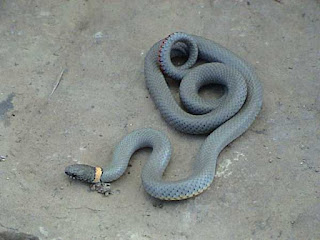 |
| Diadophis punctatus |
If you do happen to come across one, you would notice their small size (up to 15in) and their name-sake ringed neck. Most of the subspecies have some variation of this band, and it ranges in color from yellow to red. You also may notice their undersides, as they tend to flip upside down, striking a strange, defensive warning pose when threatened. Though their tops are olive green, brown, or grey, their undersides are vibrantly yellow, orange, or red.
Not so unsurprisingly, Ringneck Snakes have been little observed in the wild. Only around 6 instances of mating have ever been recorded. One might think that to be enough to get a general idea, but the snakes appear to have varied social structures. While the mating act may be similar (female attracts male with pheromones, male bites female on neck), the egg laying and hatching varies. Some of the Ringneck Snakes live alone, while others live in colonies of up to 100. In those larger groups, communal nests are more common, while single snakes nest alone. Only one brood is produced each year, with mating taking place either in spring or fall (delayed fertilization is possible), and hatching occurring in August and September.
It is estimated that Ringneck Snakes have a lifespan of up to 20 years, though the oldest in captivity only made it to 6. They feed on Salamanders, Frogs, and invertebrates, using some constriction to secure their prey, and then injecting it with venom to finish it off.
IUCN Status : Least Concern
Location : North America
Size : Body Length up to 15in (38cm)
Size : Body Length up to 15in (38cm)
Classification : Phylum : Chordata -- Class : Sauropsida -- Order : Squamata
Family : Colubridae -- Genus : Diadophis-- Species : D. punctatus
Family : Colubridae -- Genus : Diadophis-- Species : D. punctatus
I am often to blogging and i really appreciate your content Fishing in Dubai.
ReplyDeleteI have a ringneck snake who lives in my garden. I find her quite often, handle her for a few minutes and then set her back in the flower bed, where there are red backed salamanders under every other rock. I hope my handling her doesn't stress her. Is it silly to think she would get used to seeing me and being handled? ..without jeopardizing her expected natural lifespan?
ReplyDelete